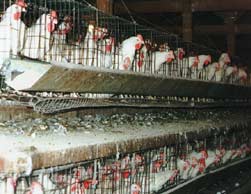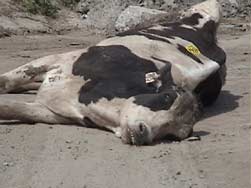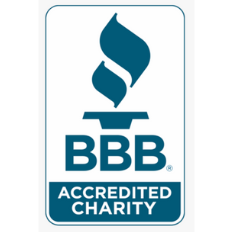Factory Farming
97% of the 10 billion animals tortured and killed each year are farm animals.
Factory farming is an industrial process in which animals and the products they generate are mass produced. The animals are not seen as an individual, sentient beings with unique physical and psychological needs but as eggs, milk, meat, leather, etc. Because factory farming is a business, its goal is to maximize production and, consequently, profit. Since the animals are seen as mere commodities, they are bred, fed, confined, and drugged to lay more eggs, birth more offspring, and die with more meat on their bones.
Farmers cut costs by feeding animals the remains of other animals, keeping them in extremely small and soiled enclosures, and refusing to provide bedding. Because animals live in such a manner and are denied normal social interactions, they experience boredom and stress so great that it leads to unnatural aggression. To curb this aggression, conceal the disease that results from such horrendous living conditions, and stimulate aberrant growth, farmers routinely administer drugs to animals, which in turn reach meat-eating consumers. The consequences of this agribusiness are institutionalized animal cruelty, environmental destruction, and resource depletion, and health dangers.
Chickens
BROILER CHICKENS
Farmers get more money for chickens with enlarged thighs and breasts. As a result, they breed the animals to be so heavy that their bones cannot support their weight. Consequently, the chickens have difficulty standing, and their legs often break. Like other factory farmed animals, broiler chickens are raised in such overcrowded enclosures that they become aggressive. To stop them from fighting with one another, their beaks and toes are cut off without anesthetic. Some cannot eat after being "debeaked" and starve. They never breathe fresh air but instead inhale ammonia day after day.
Diseases Common to Broiler Chickens:
- Respiratory diseases
 Chicken factory farm
Chicken factory farm - Bacterial infections
- Keratoconjunctivitis
- Dehydration-induced ailments
- Heart attacks
- Congestive heart failure
- Heat prostration
- Osteoporosis
- Cancer
- Crippled legs
LAYER CHICKENS
Layer chickens lay 90-95% of the eggs sold in the U.S. Newborn chicks are placed on a conveyor belt where a worker picks each one up to see if it is male or female. Newborn males are placed in trash bags and suffocated, decapitated, gassed, crushed, or ground up alive. Newborn females are placed back on the belt. The next worker then picks up the female chick, holds her up to a machine's hot iron which cuts off her beak, and then places her back on the belt. The beaks of these birds are removed because five to eight of them are crammed into 14 square inch cages, cages so small that the birds cannot even spread their wings. Such close confinement, which averts their natural social order, causes aggression among the birds. Debeaking prevents them from harming one another, which would make their corpses less profitable to the farmers. It is a painful practice that involves slicing through bone, cartilage, and soft tissue.
The floors of layer hens' "battery cages" are made of extremely uncomfortable wire, which chafes their skin, rips out some of their feathers, bruises their bodies, and deforms their feet. The cage floor slopes at the bottom, so weaker hens are often crushed on the cage base. Layer hens' bones are so brittle that they often shatter during handling. Approximately one in five dies of stress and disease. Others are ground up and turned into animal feed on site.
Forced Molting
 Parkhurst investigation - chicken farmLayer hens are exposed to light constantly so that they will lay more eggs. At the end of their laying cycle, they are killed or subjected to "forced molting," a process that entails withholding food and water for up to 18 days and keeping them in darkness so that their bodies are shocked into another laying cycle. Many of the birds who undergo forced molting die from fatigue.
Parkhurst investigation - chicken farmLayer hens are exposed to light constantly so that they will lay more eggs. At the end of their laying cycle, they are killed or subjected to "forced molting," a process that entails withholding food and water for up to 18 days and keeping them in darkness so that their bodies are shocked into another laying cycle. Many of the birds who undergo forced molting die from fatigue.
Diseases Common to Layer Hens:
- Cage Layer Fatigue
- Respiratory diseases
- Bacterial infections
- Fatty Liver Syndrome
- Broken bones
- Paralysis
Hens normally live 15 to 20 years. Layer hens are slaughtered when they are one to two years old.
Turkeys
Turkeys are given less than three square feet of cage space. The end of their beaks are cut off and their toes are clipped, both without anesthesia. Farmers get more money for turkeys with enlarged breasts. They thus breed the animals to be so heavy that their bones cannot support their weight. As a result, turkeys have difficulty standing and their legs often break. Moreover, they are so heavy that they cannot reproduce naturally. Consequently, they must be artificially inseminated.
The Slaughterhouse
Turkeys are loaded onto a conveyor belt. Some fall onto the ground instead of landing on the belt. Because workers are in such a rush, they rarely pick up those that have fallen. As a result, some birds die after being crushed by machinery operated near the unloading area. Others succumb to starvation and exposure.
Inside the slaughterhouse, the turkeys are hung by their feet from metal shackles on a conveyor belt. Their heads are dunked in the stunning tank, an electrical bath of water. Because too much electricity would damage the turkey's carcass, therein diminishing its sale value, the electrical current is often set lower than that necessary to render the birds unconscious. Thus many birds emerge from the tank still alert. The turkeys' throats are then cut. The blade misses some birds, who move on to the next assembly line station, the scalding tank, a cistern of boiling hot water. Those birds, nicknamed "redskins," are boiled alive.
Cows
"The time will come when men such as I will look upon the murder of animals as now they look upon the murder of men," — Leonardo da Vinci
CATTLE RAISED FOR BEEF
Range cattle are frightened and confused when humans come to round them up and pack them onto trucks; injuries often result. During transport, they are frightened, exposed to severe weather conditions, and deprived of d, water, and veterinary care. The cows are taken to auction where they are sold to the highest bidder, then returned to the range, taken directly to slaughter, or brought to a feedlot.
Cattle are then burned with a hot iron brand without anesthetic so that is clear who "owns" them. Beef cattle are also subjected to "waddling," during which ranchers cut chunks out of the hide (which hangs under their neck) for identification purposes. Finally, they are castrated and de-horned without anesthetic.
Feedlots
At feedlots, beef cattle live in dusty holding pens where they are forced to eat and sleep in their own excrement. They are given growth hormones and because the air is so full of bacteria, many contract respiratory disease.
Diseases Common to Cattle Raised for Beef
Cancer eye
Respiratory disease
Metabolic disorders
The Slaughterhouse
Approximately 250 cows are killed every hour at the typical beef slaughterhouse. Because workers are in a rush to stay on schedule and kill such a large number of animals in such a short period of time, the animals are often treated rather cruelly. To accustom themselves to life at the slaughterhouse, workers must become desensitized to the animals' suffering and conceive of these sentient creatures as mere objects; this conceptualization obviously leads to inhumane treatment. Moreover, the turnover rate at slaughterhouses is so high that there are a lot of new, inexperienced technicians who cannot properly sedate cows, among other things. Although cattle are supposed to be rendered unconscious before being killed, workers frequently do not successfully "stun" the animals. As a result, conscious, struggling cows are hung upside down. Their throats are then cut.
Dairy Cows
Dairy cows live in crowded pens or barns with concrete floors. Milking machines often cut them and cause other injuries. Some give them electrical shocks which cause extreme pain and even death. Dairy cows are forced to produce 10 times more milk than they would produce in nature. As a result, they experience numerous health problems.
Diseases Common to Dairy Cows:
- Mastitis (a bacterial infection of the udders)
- Bovine Leukemia Virus
- Bovine Immunodeficiency
- Johne's Disease
- Milk Fever
- Metabolic disorders, such as ketosis and laminitis
- Birth defects caused by Bovine Growth Hormone
- Udder ligament damage
Drugs Given to Dairy Cows:
- Bovine Growth Hormone
- Prostaglandin
- Antiobiotics
- Tranquilizers
Cows normally live 20 to 25 years or more. Dairy cows are slaughtered when they are three or five years old, mostly for use in fast food hamburgers.
Dairy Calves
After dairy cows give birth, their calves are separated from them, a practice which causes cows great sadness: they can be heard bellowing for their young. They are then milked repeatedly for the fluid meant for their calf. Female dairy calves replace older dairy cows who can no longer give as much milk as farmers demand. Male calves are raised and killed for their meat, both beef and veal.
Veal Calves
Veal calves live in small wooden crates; some are chained. They cannot turn around or even stretch their legs. The floors of their stalls are slatted, causing them severe joint and leg pain. Since their mother's milk is taken for human consumption, they are fed a milk substitute deficient in iron and fiber. In other words, they are deliberately kept anemic and their muscles are atrophied so that their flesh will be pale and tender. Craving iron, they lick the metallic parts of their stalls, even those covered in urine. Water is often withheld from them. Some are killed when they are only a few days old to be sold as low-grade veal for frozen dinners and the like. The rest are slaughtered when they are 16 weeks old; they are frequently too sick or crippled to walk. Ten percent of veal cows die in confinement. They never see the sun, touch the Earth, or taste the grass.
Diseases Common to Veal Calves:
- Chronic pneumonia
- Scours
- Anemia
"Nothing more strongly arouses our disgust than cannibalism; yet we make the same impression on Buddhists and vegetarians, for we feed on babies, though not our own," —Robert Louis Stephenson
Pigs
Sows
Female pigs are kept pregnant continually. After being impregnated, sows are placed in 18 to 24 inch wide pens or metal gestation crates. There is barely enough room for them to stand up and lie down. They cannot walk or turn around. Because straw is considered too expensive, they are not given bedding but instead forced to lie on hard floors which, in part, cause crippling leg disorders. Sometimes they are tied to the floor by a chain or strap. The pigs become so bored and stressed that they bite the bars of their cages frantically or rub their snouts back and forth across the front of their crate incessantly.
After giving birth, sows are only permitted to nurse their newborns for two to three weeks, as opposed to the 13 to 17 weeks they would naturally spend. The piglets are then taken away to be fattened up. By that time, approximately 15% of the newborns will have died. The sow is then reimpregnated, sometimes by being strapped to a "rape" table. When she can no longer breed at such a rapid pace, she is killed.
Piglets
Each piglet's tail is cut off without anesthesia so that other piglets will not bite it; tail biting is an unnatural behavior that results directly from the stress of the factory farm. For identification purposes, notches are removed from the piglets' ears. They are then placed in overcrowded pens with floors made of wire mesh, metal, fiberglass, or concrete. They are not given any straw or other bedding. The stress and disorder of such intense confinement drive some pigs to cannibalism. When they reach six months of age, they are slaughtered for their meat.
Diseases Common to Confined Pigs:
- Pneumonia
- Porcine Reproductive and Respiratory Syndrome
- Miscellaneous respiratory diseases
- Swine arthritis
- Salmonellosis
- Epidemic transmissible gastroenteritis
- Bratislava
- Parvovirus
- Dysentery
- Cholera
- Trichinosis
The Slaughterhouse
Pigs are hung upside down by their back legs to be slaughtered. Because swine workers, like cattle workers, are in a rush to stay on schedule and kill a large number of animals in a short period of time, the pigs are often treated inhumanely. To accustom themselves to life at the slaughterhouse, workers must desensitize themselves to the animals' suffering and conceive of them as mere objects; this approach clearly leads to inhumane treatment. Moreover, the turnover rate at slaughterhouses is so high that there are a lot of new, inexperienced technicians who cannot properly sedate animals. Although pigs are supposed to be rendered unconscious before being killed, workers frequently do not successfully "stun" them. As a result, conscious, struggling pigs are hung upside down. If a worker does not successfully knife them in the neck, they are dunked in the scalding tank and boiled alive.
Horses
Every year, 100,000 horses are killed in U.S. slaughterhouses while others are shipped to Canada and Mexico to be killed. Former racehorses, carriage horses, draft horses, and abandoned pets are killed for their meat. In addition, the manufacturers of Premarin, an estrogen replacement drug derived from pregnant mare urine, supply a number of horses for human consumption. The mares' offspring are raised for slaughter, and spent mares will also be killed for their meat.
Seafood
Farm-raised Fish
Fish, like all other vertebrates, feel pain. Farmed fish are crowded into such small enclosures that disease and suffocation are common. Since the water the fish swim in is filled with excrement and other health dangers, farmers feed fish chemicals, herbicides, and drugs, which end up in the bodies of fish-eating consumers. When the fish reach slaughter weight, they are placed in trucks and taken to the kill plant. Once there, they are poured into large metal mesh cages. Those who have survived the transport die of suffocation.
Wild Fishing
Wild fish species and populations have been destroyed by the sea industry. Other sea life, such as dolphins, are often caught in fishermen's nets. This "by-catch," in the form of 80,000 marine mammals each year, is often dead when it is thrown back into the water.
Foie Gras
Foie gras is geese and duck liver which has been enlarged by forced-feeding. Workers generally force open ducks' bills and shove a long, metal pipe down their throats. Many of the ducks' stomachs burst from overfeeding. Infection, particularly pneumonia, is common since the same pipe is used on many ducks without being cleaned. They experience additional injuries as a result of being carried around by their necks.
"We are the living graves of murdered beasts, slaughtered to satisfy our appetites. How can we hope in this world to attain the peace we say we are so anxious for?" —George Bernard Shaw
Downed Animals
Downed animals are those that are so sick or injured that they cannot walk. They collapse in farms and stockyards and sometimes remain there for days. They are then usually dragged with chains and wenches or pushed with tractors or forklifts to the slaughterhouse or the "deadpile".
Free Range Farms
The United States Department of Agriculture, which regulates free-range products for labeling purposes, relies upon the producer's word that the farm animals are indeed free range. A farmer could, therefore, label a product "free-range" when in fact it is not. Moreover, there are very few requirements for labeling products "free range." For instance, birds raised for meat may be called "free-range" if they have some sort of access to the outdoors, regardless of how much space each individual animal has.
Free-range farm hens are unable to lay enough eggs to be considered profitable after one or two years. They are then typically sold to slaughterhouses or live-poultry markets (where Santeria practitioners often purchase animals to use in religious rituals). As on factory farms, free-range, male chicks are considered worthless: At birth, they are dumped into trash cans and suffocated, ground up alive, or sold to laboratories. And like factory farm animals, when free-range animals can no longer produce, in other words, when they are no longer profitable, they are killed.
Leather
Some argue that there is no harm in wearing leather since the cows (or other animals) used to produce it are already dead, i.e. slaughtered for their meat. However, the animals are dead because there is a demand for their flesh and skin. If the demand for meat and leather decreases, fewer animals will be killed. Thus turning away from leather and toward more humane alternatives will save animal lives.
Leather is inextricably linked to the modern day factory farming system, an industrial process in which animals and the products they generate are mass-produced. The animals are seen not as an individual, sentient beings with unique physical and psychological needs but as a means to an end- meat, leather, and so on. Because factory farming is a business, its goal is to maximize production and, consequently, profit. And since the animals are seen as mere commodities in this quest, they are bred, fed, confined, and drugged to lay more eggs, birth more offspring, and die with more meat on their bones. Farmers cut costs by feeding animals the remains of other animals, keeping them in extremely small and soiled enclosures, and refusing to provide bedding. Because animals live in such a manner and are denied normal social interactions, they experience boredom and stress so great that it leads to unnatural aggression and even self-mutilation. Most leather comes from factory farmed dairy cows and veal cows.
Some of the Animals Killed to Make Leather:
• Cows
• Alligators
• Crocodiles
• Horses
• Sheep
• Lambs
• Pigs
• Goats
• Ostriches
• Dogs
• Cats
The Environment
Leather production harms the environment in several ways. First, tanning prevents the leather from biodegrading. Tanneries use toxic substances to tan leather, and tannery effluent contains large amounts of other pollutants, such as protein, hair, salt, lime sludge, sulfides, and acids. Hazardous substances like formaldehyde, coal tar derivatives, mineral salts, oils, dyes, and finishes are used to turn animal skin into leather; some of them are cyanide-based. Tanneries release elevated levels of lead, cyanide, and formaldehyde into the groundwater. Such high levels result in increased rates of leukemia.
The leather industry is inextricably tied to the meat industry, as the majority of cows used to make leathers are dairy and veal cows who live on factory farms. Factory farms consume enormous quantities of fossil fuels, water, land, and other resources. They are filled with noxious fumes, dust, bacteria, and decaying feces, all of which they release into the environment. Animal wastes carry pesticides, bacteria, and viruses; the wastes pollute drinking water with high levels of nitrates, which can be potentially fatal to infants.
How You Can Help:
• Go vegan! Stop eating animals and animal products.
• Ask restaurants to serve more vegan d and to remove veal from their menus.
• Ask supermarkets to carry more vegan products.
• Support downed animal protection legislation and legislation that abolishes battery cages, veal crates, force-feeding, and intensive-confinement systems.
• Educate others about the cruelty involved in factory farming.
![]() Learn more about: Veganism
Learn more about: Veganism













